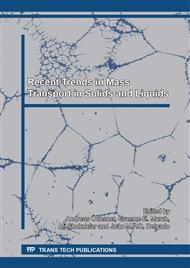p.1
p.12
p.29
p.35
p.39
p.48
p.55
p.60
p.66
Control of Particle Size and Morphology of MOF-199 Crystals via a Reaction-Diffusion Framework
Abstract:
A reaction-diffusion framework (RDF) is used to synthesize and control the size and morphology of single crystals of metal-organic framework-199 (MOF-199). The framework consists of diffusing copper ions (Cu2+, outer electrolyte) into a hydrogel medium containing the organic linker, 1,3,5-benzenetricarboxylic acid (BTC, inner electrolyte). The resulting supersaturation gradient, and its nonlinear coupling with nucleation and growth kinetics, provides means to control the crystal size, distrubution and morphology along the diffusion flux. This method is rapid, efficient, scalable, and environmentally friendly. By using this method we demonstrate how assorted experimental parameters, such as temperature, concentrations, and nature of the gel matrix can be easily tuned to produce different particle size distributions and various morphologies.
Info:
Periodical:
Pages:
39-47
Citation:
Online since:
November 2017
Authors:
Keywords:
Price:
Сopyright:
© 2017 Trans Tech Publications Ltd. All Rights Reserved
Share:
Citation:


